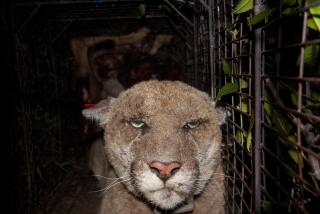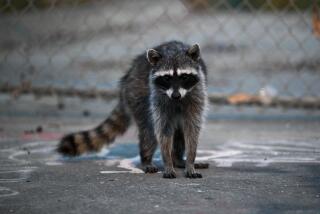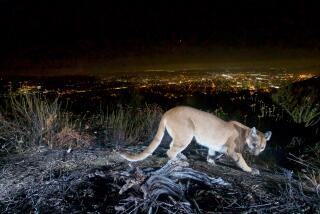Two mountain lions found dead in Santa Monica Mountains had ingested rat poison
Two mountain lions were found dead in the Santa Monica Mountains in the last two months, both with rat poison in their bloodstream, officials announced Tuesday.
P-30, a 6-year-old male, was found dead Sept. 9 by biologists in Topanga State Park after his collar sent out a mortality signal.
The big catâs body showed no sign of trauma, but a necropsy found that he had bled to death internally as a result of rat poisoning. The report indicated P-30 had severe hemorrhaging in his brain and abdominal cavity. Five liters of unclotted blood were found in his abdomen, according to a news release by the National Park Service.
Five poison compounds â all of them rodenticides â were found in his body: bromadiolone, brodifacoum, chlorophacinone, difethialone and diphacinone.
As the mountain lions of Southern California approach what some experts call an âextinction vortex,â environmentalists are demanding that state officials grant the big cats protective status â a move that could potentially ban development on thousands of acres of prime real estate.
P-30 is the fifth mountain lion in the National Park Serviceâs study of the big cats since 2002 to die as a direct result of rat poison, officials said. A 3-year-old mountain lion known as P-47 died in March after being infected with rat poison, parks officials said. And in 2015, the photogenic P-34 died of exposure to rodenticides, a necropsy showed.
Rat poisons are designed to kill low-on-the-food chain rodents by thinning their blood and preventing clotting. They lead to uncontrollable bleeding, and when apex-predator big cats eat the vermin, they ingest the poisons.
Among the two recent deaths, the body of a 4-year-old female mountain lion known as P-53 was found Aug. 15 in Malibu. Her carcass was too decomposed to determine an exact cause of death, but tests showed many of the same poisonous compounds found in P-30 in her liver, park officials said.
Earlier this year, P-53 had been diagnosed with the skin disease mange, which has been linked with wild catsâ ingestion of rat poison. Researchers donât fully understand the nature of the link between rat poison and mange but have said itâs likely that rat poisons weaken the catsâ immune systems, making them more susceptible to the skin disease.
In bobcats, fatal mange is highly correlated with the degree of their exposure to rat poisons. Studies by UCLA and the National Park Service have found bobcats exposed to rat poison have weaker immune systems and altered gene expression.
âThe same level of investigation has not been possible to date with mountain lions, but all five mountain lions in the NPS study that have become sick with mange ⦠have also been exposed to these toxicants,â park officials said in a news release.
P-53 was treated for mange and recovered from the skin disease before being found dead six months later, park officials said.
More to Read
Sign up for Essential California
The most important California stories and recommendations in your inbox every morning.
You may occasionally receive promotional content from the Los Angeles Times.











